History
The Founding of the Montauk Fire Dept.
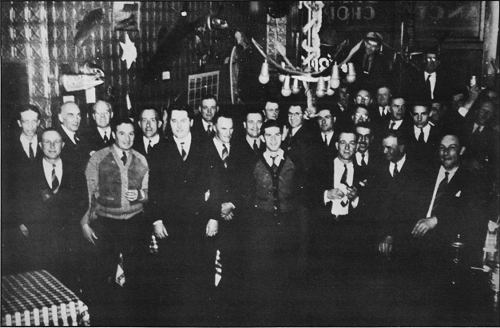
Officially, the Montauk Fire Department was created on March 16, 1939, when the East Hampton Town Board passed a resolution appointing six Montauk residents to serve as a board of fire commissioners for the newly established fire district in central Montauk. They served an appointed term until the end of the year when an election was held by the resident voters of the district. The men elected to serve as the first Board of Fire Commissioners were Capt. J.C. Wells, Thomas E. Ringwood, Guy Duval, William Belber, Charles Bonner, and E.V. Conway, Treasurer.
However, just for the record, Montauk did have a makeshift fire-fighting system before that. Back in 1927, The Montauk Beach Company bought and equipped a Graham truck to serve as a community fire truck and appointed one of their employees, Chief Figon, to be in charge of it. They did rely on the help of the townspeople to fight any fires, so the truck was kept in a small shed located on Edgemere Street about where the ball diamond of Lion's Field is now. A large metal ring was suspended between two poles nearby along with an iron bar to whack it with. This was the town's fire alarm. If a steam locomotive happened to be at the depot at the time, the engineer would add his whistle to make sure everyone in town came a-running.
This arrangement proved unsatisfactory after a few years. Too often, when needed, the truck would either have a dead battery, an empty gas tank, or a frozen water supply. Times were tough. The stock market crash of '29 had wiped out Carl Fisher's great plan to make Montauk the "Miami Beach of the North."
Nevertheless, despite the depression, the people of Montauk went ahead with plans to establish a real Montauk Fire Department, no matter what it cost. Here is a quote from the September 8, 1938 issue of the East Hampton Star: "A capital outlay for the purchase of a fire truck, hose and equipment, repair or purchase of a firehouse and other items are estimated to run close to $10,000.00, and it is proposed to finance this expense over a ten year period."
[ back to top ]
The Early Days of MFD
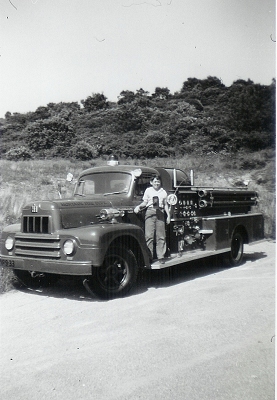
Two weeks after that initial estimate was published, the great hurricane of '38 hit Montauk. Instead of being discouraged, the people of Montauk were all the more convinced that they needed a real community emergency service, for just six months later, the Montauk Fire Department was born. The voters went so far as to approve the spending of $12,500.00 and bought two fire trucks! That sum also covered converting the old schoolhouse into a firehouse and building a new garage behind it! Compare that with today's costs of $165,000.00 for a new pumper and well over a million to put an addition onto the firehouse.
The early days of any organization are the most interesting. There is a certain spontaneity and innocent clumsiness that pervades the actions of all concerned. Precedent hasn't been set and characters haven't been refined. The early mistakes that are bound to happen can be excused both for lack of experience plus a little too much gung-ho enthusiasm. Montauk had its share of gung-ho characters. I shall not risk naming names as that would spoil the fun. Just bear in mind that most of the year-round residents of Montauk fifty years ago were rugged individualists who made a precarious living from the sea by their own wits and initiative. They were not the type who would take orders from someone else. This resulted in some Keystone Kops capers right out of a Mack Sennet comedy.
Picture this: Both of the above-mentioned fire trucks were housed in a side-by-side basement garage dug into the side of the hill behind the firehouse. Overhead doors hadn't been invented yet (or if they had, were too expensive for an embryo fire department). The common, swing-open doors were unacceptable due to the possibility of heavy snow piling up in front of them. The obvious solution was sliding doors, which could not be sealed closed by drifting snow. The drawback to sliding doors was that only one door could be opened at a time since they slid alongside one another. The first driver to arrive only had to slide one door open and hop in the truck and go. The second had to wait until the first truck left, then push two doors open before he could go.
This naturally set up a race situation as far as the volunteer drivers were concerned. At the first wail of the siren, men would converge on the firehouse at breakneck speed, not so much to put out the fire, but to be the first out of the barn. There was an added obstacle in the race: all firemen were supposed to run up the hill the firehouse stood on, then up the front steps and into the hall where the firehouse custodian wrote the location of the fire on a blackboard. He did this so he could get back on the phone when the chief called. But some drivers would take a shortcut down the driveway and slide open the doors from the outside, hoping that another member of their company would find out where the fire was and hop on after the truck was first out of the barn. There were occasions when the first truck would go roaring off in less than a minute after the siren sounded, but without any idea where the fire was.
[ back to top ]
Montauk Was A Different Place
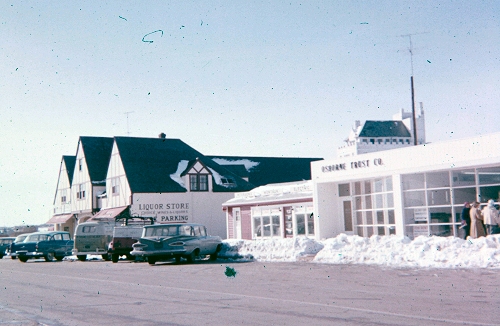
Most of the fires in the early days of the department were brush fires, not house fires. These were fought primarily with brooms and Indian cans. Montauk was much more open back then. It was mostly grassland with pockets of scrub oaks and shad bushes in lowland areas. It was sparsely settled with most of the houses clustered around the Fort Pond central district. Unbroken fields extended across areas that are now developed neighborhoods. If a grass fire got a good start in areas like that, it couldn't be stopped until it reached a road or firebreak. It was along these roads that the firemen would start a backfire that could be controlled as it ate its way upwind until it met the downwind fire wall. This deprived the fire of fuel and it would die. Speed is essential in fighting any fire, but more so in fighting a grass fire. The fire may start in a small circle, but doubles its size every few seconds. As soon as the truck arrived, the first firemen on the scene would grab all the brooms and start to beat out the expanding ring of fire. Those that arrived later paid the penalty of having to strap an Indian can (a five gallon tank of water) on their back and lug it to the fire and squirt it out with a hand-operated hose pump. Lugging Indian cans was the least desirable job in the Fire Department and is the reason why most of the volunteer firemen tried to be the first at a fire.
The Montauk taxpayers got their money's worth out of those first two Dodge fire trucks. Purchased in 1939, they cost $3,328.00 and $2,564.000, respectively. For fifteen years they were the department's only fire trucks. They had to carry their own water supply, (250 gallons) as well as a full bed of hose, ladders, a reel of high pressure hose, coats, boots and hats, axes, shovels and hooks, brooms and Indian cans, plus two lengths of stiff suction hose to suck up water from wells, ponds or the harbor. Add a half-dozen firemen as well and you can understand why these trucks could not make it up some of Montauk's steeper hills. But the roughest duty they performed was fighting fires along the railroad tracks in Hither Woods and the State Park.
[ back to top ]
LIRR Was Still Using Steam Locomotives
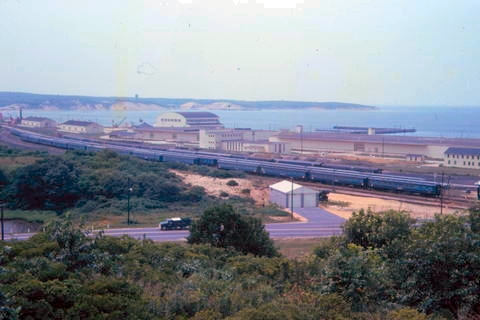
The Long Island Railroad was still using steam locomotives which had a habit of shooting sparks into the air as they chugged up the hills. When the woods were dry it was easy to start a fire that fed on the dead leaves and humus. Rocky, unpaved roads were the only way into the area and the fire trucks took a beating trying to get near these fires. They were not fourwheel-drive and had no skid plates to protect the undercarriage from large rocks and fallen tree limbs. In 1940, the department had to fight a fire in the State Park that was almost as bad as the forest fire that roared through Hither Woods in 1986, but they had to do it with only those two Dodge trucks. When the Commissioners bought a new pumper in 1954, all firemen were notified that the new truck was NOT to be driven off-road back in the woods. For the record, the new pumper cost $13,071.00, more than twice as much as the first two trucks put together!
[ back to top ]
Those Two Old Trucks
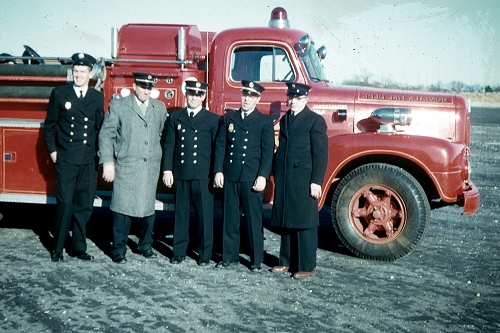
Those two old trucks continued to serve Montauk valiantly. They were never sold or traded in, but were repaired and maintained in service until one of them was burned in the N.Y. Ocean Science complex during a fire in 1968, and the other was finally retired in 1974. It served our community for thirty-five years and has recently been lovingly restored to its original condition to take its place of honor in the Montauk Fire Department's Fiftieth Anniversary celebration. Let's see, at an original cost of $3,328.00 for thirty-five years service, that comes to S95.08 a year. I'd say the Montauk taxpayers got their money's worth. They just don't make fire engines like that anymore. Our newest pumper, a 1985 Pierce, cost $164,791.00 and would have to be in service for 1,735 years to equal that record'.
However, the third vehicle acquired by the Montauk Fire Department was not a fire truck, but an ambulance, and it didn't cost the taxpayers anything. It was a gift from Russ MacGrotty, a summer resident and avid fisherman, who gave a Chevrolet ambulance to the community after an open-party boat sank off Montauk Point. This disaster demonstrated how badly Montauk needed an ambulance service and shortly thereafter, in 1952, the Montauk Emergency Relief Squad was created as part of the department. All sixteen members were qualified firemen and volunteered to answer ambulance calls as well as fulfilling their fire company duties.
[ back to top ]
The First Firehouse
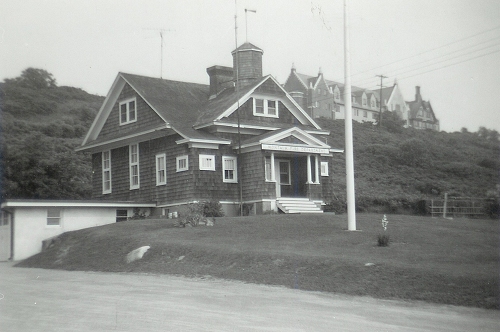
Because there was no space for it in the firehouse, the ambulance had to be kept in the Town Highway Department barn on Industrial Road. We operated out of this Facility until an extension was built onto the firehouse garage to accommodate the new pumper in 1954. It still had sliding doors but there were no more races to see which side was opened first because the new pumper was assigned the privileged status of being the first vehicle out. The ambulance was stored alongside, with the old trucks in back. This cumbersome arrangement continued until the new firehouse was built in 1962, but to this day, the old garage behind the firehouse is still in active use.
I still recall the "old" firehouse with nostalgic affection. It had been a schoolhouse, and had one classroom on the ground floor that became the meeting room. A small room off the front hall was converted to a kitchen, there were two small restrooms off the hall plus two stairways, up and down. The upstairs was an apartment for the firehouse custodian and his family that were on duty to answer the phone and blow the whistle twenty-four hours a day, seven days a week, fifty-two weeks a year. This man was Louis McDonald who served in that capacity for twenty years. The ambulance added much more responsibility to his job. With a fire, all he had to do was blow the whistle and everybody came running. With the ambulance, he had to telephone the assigned drivers for the week until he could get two that were home and could respond immediately. When he failed, he turned to me as a backup because he knew I worked at home and could drop everything and go. Louie and I got to be very good friends during my eight years on the ambulance squad.
All of our meetings, fire school training and even social affairs were held in that old class room, along with a pool table covered with waterproof canvas. Memorable New Year's Eve parties were held there with every couple bringing a covered-dish contribution to the feast. We would even import Red Lincoln and his three piece orchestra from Southampton to play for the dancing. I've been to a lot of fancier places for New Year's Eve, but none where I've had as much fun as at the old firehouse.
[ back to top ]
The New Firehouse
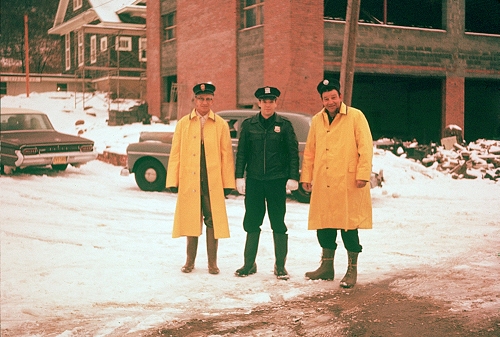
The Department underwent its greatest change when the old firehouse was sold and moved off the property to make room for the present building in 1962. Suddenly we had six bays with electric overhead doors and only four vehicles. That changed shortly with the addition of a secondhand tanker and a new Cadillac ambulance.
[ back to top ]
The Old Chevrolet
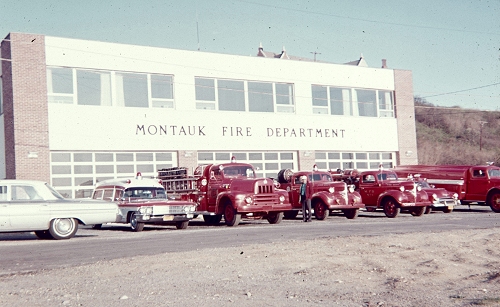
The old Chevrolet was still in good condition but was unsatisfactory
for transporting heart attack victims. It was actually a station wagon
that had been lengthened to accommodate a stretcher. However, it did
not have enough headroom to allow the patient to sit upright. Some
heart attack victims have difficulty breathing in a reclining position,
and on some of our runs to the hospital we had to put the patient in
the front passenger seat next to the driver, while the attendant held
the oxygen mask to his face from behind. The new ambulance was built as
an ambulance and had space to properly transport the sick or injured.
However, the old ambulance was kept to be used on house fire calls and
as an emergency back-up.
[ back to top ]
Montauk Was Growing
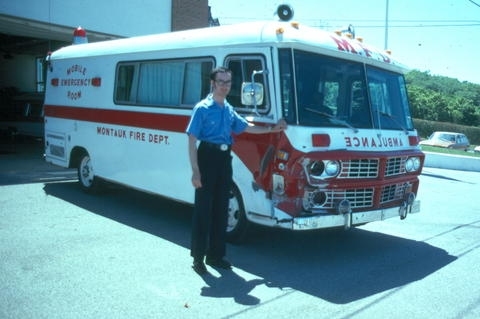
Montauk was growing and so was its need for fire equipment. The department kept pace by aquiring newer and bigger and more powerful fire engines, tankers, four-wheel drive brush trucks, rescue trucks, chiefs' cars, advanced life support ambulances, and finally, a tower ladder truck. When the new firehouse and the garage behind were filled to capacity, the department built an auxiliary engine house across Fort Pond on Second House Road in 1975. This move not only solved the storage problem, but ensured that four of the fire trucks would be available on the west side of Montauk in the event that the two connecting roads were flooded during a hurricane.
[ back to top ]
Additional Equipment
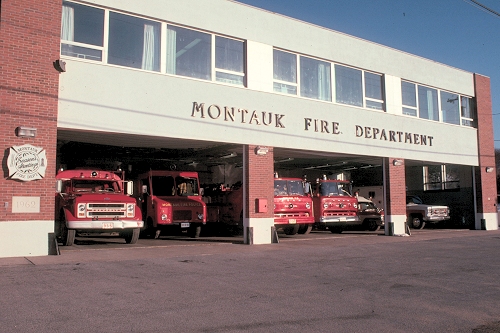
Additional equipment required additional manpower as well, and the once small department consisting of two companies swelled to five. There are now three engine companies, one truck company and one ambulance company - plus a Fire Police squad made up of members of all companies. As of April 1989, there were ninety-one members making up the roster of the Montauk Fire Department. Firefighting is not only dangerous but requires physical strength as well. For this reason Fire Departments had always been an all-male quasi-military organization. However, it was the ambulance service that finally opened the doors to women. It still was dangerous, especially on drug-related calls, and it still requires physical strength to carry a 250 pound patient down a stairwell strapped to a kitchen chair. They were not just ambulance drivers anymore; they had to attend classes and pass tests in First Aid, CPR, and EMT. They had to be prepared to handle anything from an automobile crash to a heart attack to a drowning to a fire victim. The ambulances then were in radio contact with EMT headquarters. The nearest hospital was (and still is) thirty miles away. If they drove sixty miles an hour it would still take them half an hour to get there. In summer traffic, even then it can be considerably longer. Accidents and sudden illness can happen to anyone. The people of Montauk could be proud of, and confident in, the fine service these volunteer members of our Fire Department performed. During the year of 1987, they answered over 400 ambulance calls!
[ back to top ]
Memorable Fires in Montauk
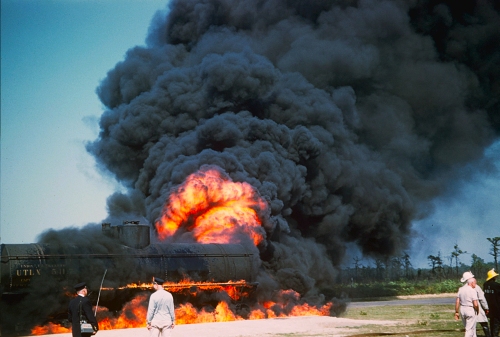
There have been a number of memorable fires in Montauk. Some of the worst were the Yacht Club and Lakeside Inn fires of 1954, a brush fire that burned from Oceanside to Ditch Plains in '55, Darenburg's Marina in '73 and '74, the old seaplane hangar in '73, the Golf Club and Peter Beard's windmill home in '75, Ronnie's Deli in '78, Sharon's Inn in '81, Hither Hills State Park and Hither Woods in '86, the IGA Supermarket fire in 1988 adn more.
[ back to top ]
A New Addition To The Firehouse
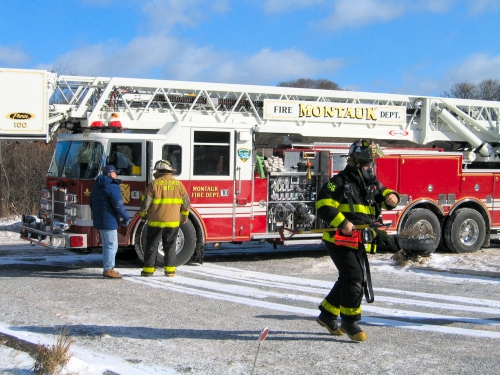
Few residents of Montauk realize that this peninsula of land we live on is almost the same size as the island of Manhattan up to the George Washington bridge. It is a considerable area for one Fire Department to protect. It has every variety of terrain, from steep rocky hills to soft sand dunes to boggy wetlands. In places this terrain is covered with virgin forest, shad bush brushland, or open grassland. The dwellings to be protected range from tents, trailers, frame suburban homes, lavish mansions, sprawling motels, hotels, and condos, to a four-story Manor and a seven-story tower. There are the usual stores, restaurants, and service businesses, and if that weren't enough, there is a harbor full of expensive boats, yachts and marinas; all potential fire starters. We even have an airport. To fight a possible fire in any one of these areas requires diversified equipment. There must be four-wheel drive brush trucks for off-road use in sand, hills or woods. There must be standard trucks with high pressure hoses for house fires, there must be a tanker to supply water beyond the hydrant districts, and there must be a tower ladder truck to rescue people from upper floors of high buildings, as well as having the capability to fight a fire from above. Lastly, we need ambulances to provide emergency medical treatment at the scene as well as transportation to the hospital. By 1989 the Montauk Fire Department had nineteen pieces of apparatus to cover this need. It was understandable why a new addition to the firehouse was necessary.
[ back to top ]
Skills, Energy and Dedication
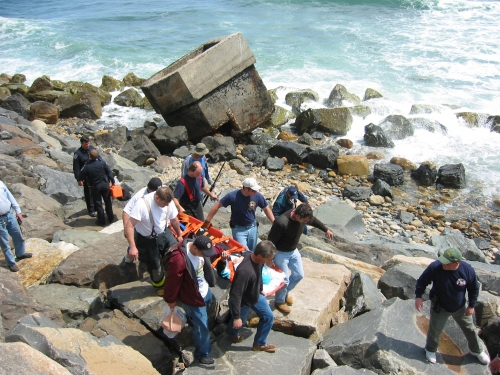
Vehicles alone do not make up a Fire Department. It requires the skills, energy and dedication of the men and women that make up the department to complete the equation. The amount of time that the members of the department contribute to their community is incalculable. Members must attend fire school sessions, practice drills, company and department meetings as a standard part of their training. That can take two nights a week on average. Actual fire fighting is extra. When the siren blows, they are expected to drop whatever they are doing and respond immediately, be it 2 a.m. or 2 p.m. They remain on duty until the fire is out, and after that they return to the firehouse and clean up the equipment so it is ready for the next call - which may be twenty minutes after they get back home. Add to this the fact that fire fighting can be dangerous work and you will have some appreciation of the contribution these people make to the rest of their neighbors in Montauk.
[ back to top ]
The Current Day
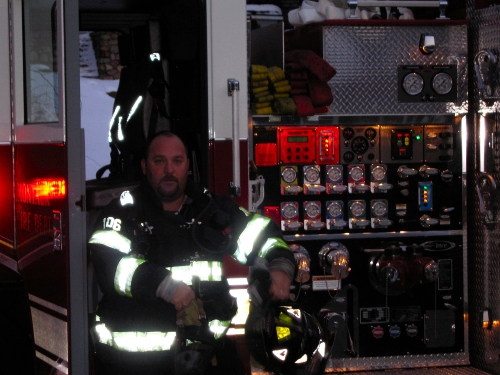
Today the Montauk Fire Department is made up of 117 members and has 21 pieces of rolling equipment (i.e. Fire Trucks and Ambulances) and continues to meet the demands and challenges placed upon them.
[ back to top ]
